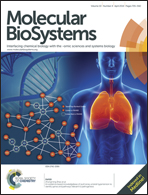Comparative metabolite profiling of foxglove aphids (Aulacorthum solani Kaltenbach) on leaves of resistant and susceptible soybean strains†
Abstract
Aphid infestations can cause severe decreases in soybean (Glycine max [L.] Merr.) yield. Since planting aphid-resistant soybean strains is a promising approach for pest control, understanding the resistance mechanisms employed by aphids is of considerable importance. We compared aphid resistance in seven soybean strains and found that strain Tohoku149 was the most resistant to the foxglove aphid, Aulacorthum solani Kaltenbach. We subsequently analyzed the metabolite profiles of aphids cultured on the leaves of resistant and susceptible soybean strains using capillary electrophoresis-time-of-flight mass spectrometry. Our findings showed that the metabolite profiles of several amino acids, glucose 6-phosphate, and components of the tricarboxylic acid cycle were similar in aphids reared on Tohoku149 leaves and in aphids maintained under conditions of starvation, suggesting that Tohoku149 is more resistant to aphid feeding. Compared to susceptible strains, we also found that two methylated metabolites, S-methylmethionine and trigonelline, were either not detected or decreased in aphids reared on Tohoku149 plants. Since these metabolites function as important sulfur transporters in phloem sap and osmoprotectants involved in salt and drought stress, respectively, aphid-resistance is considered to be related to sulfur metabolism and methylation. These results contribute to an increase in our understanding of soybean aphid resistance mechanisms at the molecular level.


 Please wait while we load your content...
Please wait while we load your content...